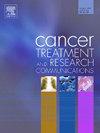Real-world comparative outcomes of EGFR-TKIs for first-line treatment of EGFR+ metastatic non–small-cell lung cancer
IF 2.4
Q3 Medicine
引用次数: 0
Abstract
Purpose
Osimertinib is a third-generation EGFR-TKI and preferred first-line (1L) treatment for EGFR positive (EGFR+) metastatic non-small cell lung cancer (mNSCLC). This study compared real-world clinical outcomes of 1L osimertinib versus 1st or 2nd generation EGFR-TKIs (1/2G-TKIs) in patients with EGFR+ mNSCLC.
Methods
Nine academic cancer centers in the US participated in the retrospective cohort study. Patients aged ≥18 years with EGFR+ mNSCLC and treated with 1L EGFR-TKI were included. Clinical outcomes included real-world progression-free survival (rwPFS), duration of treatment (DOT), time to next treatment (TTNT), central nervous system incidence-free survival (CNS-IFS), and overall survival (OS). Multivariable regression models were used to control for differences in patient characteristics (p < 0.1) between the osimertinib and 1/2G-TKI cohorts.
Results
The study included 181 osimertinib patients and 171 1/2G-TKI patients. Osimertinib had a longer rwPFS compared to 1/2G-TKIs (median PFS, 95 % confidence interval [CI]: 16.2 months (13.2–19.7) vs. 10.8 months (9.5–12.7); hazard Ratio [HR], 95 % CI: 0.60 (0.44–0.82). DOT and TTNT were significantly longer in patients treated with osimertinib versus 1/2G-TKI (HR, 95 % CI: 0.51 (0.38–0.68) for DOT; 0.54 (0.39–0.74) for TTNT). The respective HR point estimate for CNF-IFS and OS of 0.62 and 0.83 preferred osimertinib. However, small patient counts and number of events posed challenges in drawing conclusion regarding the significance of the delayed CNS-IFS or OS.
Conclusion
Patients treated with osimertinib had a prolonged time to progression and longer time maintain the treatment compared to 1/2G-TKI. This real-world evidence is aligned with clinical trial results.
EGFR- tkis一线治疗EGFR+转移性非小细胞肺癌的现实世界比较结果
奥西替尼是EGFR阳性(EGFR+)转移性非小细胞肺癌(mNSCLC)的第三代EGFR- tki和首选一线(1L)治疗药物。该研究比较了1L奥西替尼与第一代或第二代EGFR- tkis (1/2G-TKIs)在EGFR+小细胞肺癌患者中的实际临床结果。方法美国9个学术癌症中心参与了回顾性队列研究。纳入年龄≥18岁的EGFR+ mNSCLC患者,并接受1L EGFR- tki治疗。临床结果包括真实世界无进展生存期(rwPFS)、治疗持续时间(DOT)、到下一次治疗的时间(TTNT)、中枢神经系统无发病率生存期(CNS-IFS)和总生存期(OS)。多变量回归模型用于控制患者特征的差异(p <;0.1)在奥西替尼组和1/2G-TKI组之间。结果纳入181例奥希替尼患者和171例1/2G-TKI患者。与1/2G-TKIs相比,奥西替尼的rwPFS更长(中位PFS, 95%置信区间[CI]: 16.2个月(13.2-19.7)比10.8个月(9.5-12.7);风险比[HR], 95% CI: 0.60(0.44 ~ 0.82)。与1/2G-TKI相比,接受奥西替尼治疗的患者DOT和TTNT的时间明显更长(HR, 95% CI: 0.51 (0.38-0.68);TTNT为0.54(0.39-0.74)。CNF-IFS和OS的HR点估计值分别为0.62和0.83,首选奥西替尼。然而,患者数量少,事件数量多,对于延迟CNS-IFS或OS的重要性的结论提出了挑战。结论与1/2G-TKI相比,奥西替尼治疗的患者进展时间延长,维持时间延长。这一真实世界的证据与临床试验结果一致。
本文章由计算机程序翻译,如有差异,请以英文原文为准。
求助全文
约1分钟内获得全文
求助全文
来源期刊

Cancer treatment and research communications
Medicine-Oncology
CiteScore
4.30
自引率
0.00%
发文量
148
审稿时长
56 days
期刊介绍:
Cancer Treatment and Research Communications is an international peer-reviewed publication dedicated to providing comprehensive basic, translational, and clinical oncology research. The journal is devoted to articles on detection, diagnosis, prevention, policy, and treatment of cancer and provides a global forum for the nurturing and development of future generations of oncology scientists. Cancer Treatment and Research Communications publishes comprehensive reviews and original studies describing various aspects of basic through clinical research of all tumor types. The journal also accepts clinical studies in oncology, with an emphasis on prospective early phase clinical trials. Specific areas of interest include basic, translational, and clinical research and mechanistic approaches; cancer biology; molecular carcinogenesis; genetics and genomics; stem cell and developmental biology; immunology; molecular and cellular oncology; systems biology; drug sensitivity and resistance; gene and antisense therapy; pathology, markers, and prognostic indicators; chemoprevention strategies; multimodality therapy; cancer policy; and integration of various approaches. Our mission is to be the premier source of relevant information through promoting excellence in research and facilitating the timely translation of that science to health care and clinical practice.
 求助内容:
求助内容: 应助结果提醒方式:
应助结果提醒方式:


